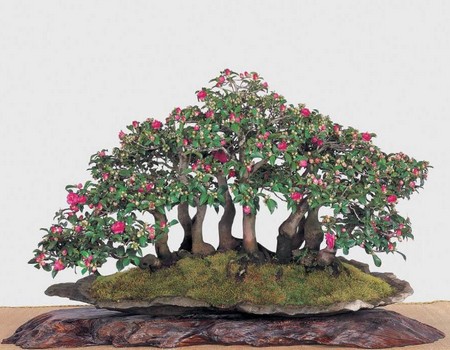Fertilization method of tea plum bonsai
There are many varieties of tea plum, mostly white flowers, a few safflower, mainly produced in Jiangsu, Zhejiang, Fujian, Guangdong and other provinces along the Yangtze River and in the south, suitable for subtropical trees. For the new pot of tea plum, there are many places to pay attention to. Special attention should be paid to fertilization, and fertilization should be done properly. For those of you who have questions about this, this article will give you a detailed answer.
1. Time for applying liquid fertilizer
Pouring liquid fertilizer is generally carried out in the evening when the temperature drops and the soil is dry. The next morning,"return water", that is, regardless of whether the soil is dry or not, water should be poured once to dilute the fertilizer solution in the soil layer to facilitate root absorption.
2. The concentration of liquid fertilizer
The concentration of liquid fertilizer depends on the length of fertilization interval, variety, seasonal alternation and plant growth. During the growth period of tea plum, it should be applied once every week or 10 days. If the fertilization interval is long, it can be applied with medium concentration of fertilizer water mixed with 10 times water. Fertilization interval is short, should reduce the concentration, with 15 times or 20 times water application. Tea plum, strong growth of varieties, fertilizer appropriate concentration. Young plants, weak plants, rare varieties, light. The first fertilization in spring should be light, and then gradually thickened. Plum rainy season soil wet, or ponding, unfavorable fertilization. Potted plants can be sprayed with fertilizer on the leaves. Growth season, fertilization can be appropriately thickened, late autumn, winter and then gradually reduce or stop application.
3. Remedial measures for excessive or insufficient fertilization
1. The leaves are dark green, the leaves are large and soft, the mesophyll color becomes pale, the flowers are few, and the legs are long, which is the symptom of excessive fertilization. Light will affect growth, development, branching, flowering, heavy will affect normal growth, causing more diseases and insect pests. At this time must stop fertilization, planting, take irrigation, drainage methods to dilute fertilizer concentration. potted plants, take soil replacement or soak;
2, such as slow growth, small and thin leaves, yellow leaves, thin leaves, which is a symptom of insufficient fertilization. The frequency and concentration of fertilization should be appropriately increased, but it should not be applied too thick and frequently.
4. In several cases, camellia should not be fertilized:
Generally speaking, flower bud color flowering period, avoid fertilization, otherwise it will cause flower drop bud.
Summer high temperature, winter semi-dormant period should not be fertilized, so as not to cause rotten roots. Branches excessive length, dark green leaves or leaves droop for a long time, which indicates excessive fertilizer or mold roots, to immediately stop fertilization.
Newly transplanted or diseased tea plum should not be fertilized. Thin fertilizer should be applied after the new plant recovers its growth function and the diseased plant is cured. For tea plum planted in autumn, no fertilizer should be applied in that year.
Generally, the tea plum in the new pot should not be fertilized. After the plant returns to normal growth, a small amount of light topdressing can be applied, and excessive concentration should not be avoided. Tea plum to use mixed organic fertilizer (human manure, manure) for good, mainly to phosphate fertilizer, nitrogen fertilizer for the secondary. If nitrogen fertilizer is too much, it will cause excessive growth of branches and fewer flowers. Can also be rapeseed cake and fish meal directly scattered in the soil surface, let it slowly rot, infiltration of the soil, for root absorption. Also may wish to apply a small amount of calcium superphosphate and other chemical fertilizers, but must be thin fertilizer less application, differential treatment: plant strong slightly more application, weak less application, sick people do not apply.
Fertilization of tea plum requires light fertilizer and full decomposition. Generally, thin nitrogen fertilizer is applied once a year from February to December to promote the growth of tea plum branches and leaves. Apply thin cake fertilizer water once between April and May to promote flower bud differentiation of tea plum. 9-10 Applying 0.2% potassium dihydrogen phosphate once a month can make the flowers of tea plum bigger and brighter.
Time: 2019-06-11 Click:
- Prev

Tea plum bonsai watering skills
For the new pot of tea plum, there are many places to pay attention to. Pay special attention to watering, watering should be done properly. For those of you who have questions about this, this article will give you a detailed answer. If you just got a pot of tea plum, and it is a new pot, first of all, pay attention to watering problems. Water thoroughly
- Next

The method of ramet propagation of Cymbidium
Smiling gentleman orchid, when the flower blossoms, it seems to bow its head and smile, so its name. The asexual reproduction of flowers has the methods of cutting, ramet, striping, grafting and so on, but the asexual reproduction of Cymbidium is generally only the method of dividing plants, and this method is more common. To propagate by means of separate plants.
Related
- Fuxing push coffee new agricultural production and marketing class: lack of small-scale processing plants
- Jujube rice field leisure farm deep ploughing Yilan for five years to create a space for organic food and play
- Nongyu Farm-A trial of organic papaya for brave women with advanced technology
- Four points for attention in the prevention and control of diseases and insect pests of edible fungi
- How to add nutrient solution to Edible Fungi
- Is there any good way to control edible fungus mites?
- Open Inoculation Technology of Edible Fungi
- Is there any clever way to use fertilizer for edible fungus in winter?
- What agents are used to kill the pathogens of edible fungi in the mushroom shed?
- Rapid drying of Edible Fungi

